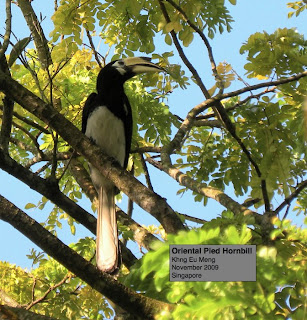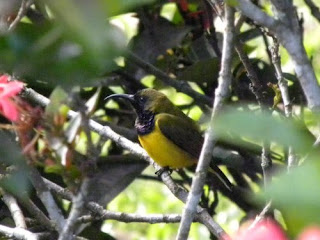Oriental Pied Hornbill
Having awakened to the thrills of birdwatching, I decided that I should look in my own backyard, right here in Singapore.
(Dec 8 -13, 2009) Botanic Gardens
Having experienced the surprises seen in the Botanic Gardens of Taipei - they sure have a good variety and number of birds there - I headed for our very own world-renowned Botanic Gardens, which celebrates its 150th Anniversary this year. "The Gardens at its present site was founded in 1859 by an Agri-Horticultural Society. Planned as a leisure garden and ornamental park, the Society organised flower shows and horticultural fetes. In 1874, the Society handed over management and maintenance of the site to the government. The scientific mission of the Gardens evolved when the colonial government assumed management and deployed Kew-trained botanists and horticulturists to administer the Gardens." (http://www.sbg.org.sg/aboutus/ourhistory.asp)
And I was very well rewarded. A fellow birder notified me that there was an Oriental Pied Hornbill on top of a tree near the gazebo. Now, this was indeed a very rare sighting of this noble-looking bird in a park in the middle of town. The hornbill stayed around for a good half hour then flew off. I felt blessed. I always dreamed of seeing a hornbill in the wild and I was told I may try my luck in Pulau Ubin where there is a pair. This is a lifer for me (though I have seen them at the Bird Park in Jurong).
Reading that Singapore doesn't actually have its own endemic bird species, and that we not only have many migratory birds passing through here but also a good number of escapees (I guess from careless owners and from the pet shops and the Bird Park). And wow, the Botanic Gardens did have a good number of these birds.
This thrush (above), endemic to India, China and Southeast Asia, was observed to visit the pools to bath every evening. Be prepared to jostle with the legions of avid photographers (not birders) who are too generous with their use of their powerful flashguns. The poor bird must have felt like a pop star pursued by the paparazzi.
Another migrant, the Hooded Pitta, was reportedly seen around the gardens. I only saw its blackish head through my binoculars and failed to capture it with my camera. One photographer showed his "catch" and it was indeed a very colourful bird. In Taiwan, they call this bird "ba shi niao" or eight-colours bird.
But for me, the kingfishers are a truly odd looking but beautiful bird, and there so many types. At the Botanic Gardens, I spied the following and they showed why they are "king of fishers":
Common Kingfisher (above and below)
 Preening after a dip
Preening after a dip White-throated Kingfisher (above and below)
White-throated Kingfisher (above and below)
Common Kingfisher
Stork-billed Kingfisher
Then there are these tiny, almost un-noticeable colourful birds that flit among the flowers. Not unlike hummingbirds, these sunbirds and flower-peckers do hover around flowers while sticking their long beaks into flowers.
And then there are the doves and pigeons, in fairly large numbers and some are quite tame to boot.
 Pink-necked Green Pigeon (male)
Pink-necked Green Pigeon (male) Pink-necked Green Pigeon (female)
Pink-necked Green Pigeon (female)As the Gardens have several ponds, waterfowls such as the White-breasted Waterhen, duck, Bitten and swan can be spotted.
 Lesser Whistling Duck
Lesser Whistling Duck
 Bitten
Bitten


 Lesser Whistling Duck
Lesser Whistling Duck Bitten
BittenIn the high canopies of the rainforest trees, one could distinctly hear the calls of the Koel, Hill Mynah and the Greater Racquet-tailed Drongo ("The Mimic") - they all have this sinister black sheen to their feathers. The Koel even has red eyes.
At around 5 p.m. when the birds come to take their supper, noisy troops of parrots, lorikeets and parakeets circle the high tree tops. I managed to capture a colourful duo as they sat on a high branch of a Tembusu tree and another one hanging for its dear life on a frond of a palm tree while swaying in the wind.
 Hanging Parrot (Unknown type)
Hanging Parrot (Unknown type)
At around 5 p.m. when the birds come to take their supper, noisy troops of parrots, lorikeets and parakeets circle the high tree tops. I managed to capture a colourful duo as they sat on a high branch of a Tembusu tree and another one hanging for its dear life on a frond of a palm tree while swaying in the wind.
 Hanging Parrot (Unknown type)
Hanging Parrot (Unknown type)There are Woodpecker, Bulbul, Mynah, Bee-eaters, Dollarbirds, Starlings, among others.
Bukit Timah Nature Reserve: If you want to a good birding trip at this venue, don't go during the weekend - there are far too many people about and the noise they make do chase away the birds from easy viewing. However, my companion's sharp eyes picked out a pair of Roufous-bellied Malkoha. Upon being spied by human eyes, they quickly flew deeper into the forest and all I had were a couple of blurrish shots. The Greater Racquet-tailed Drongo was easier to spot and they seem to like posing for photographs. They are great mimics of other bird calls, too.
Greater Racquet-tailed Drongo
Down the hill, on the path leading from the Visitors' Centre, several fruit trees were magnet for numerous birds, including Starlings, Bulbuls, Mynahs, Asian Fairy Blue Bird, among others.
Further up the path, a fellow birder chanced upon a juvenile female Emerald Dove and signalled for me to see it. This exquisite dove showed no fear of me and came as near as a metre to peck for grub on the ground.
Emerald Dove (juvenile)
A large brown Straw-headed Bulbul called loudly for the longest time ever, while a Crimson Sunbird flitted among the shrubbery looking for nectar. And trying hard to camouflage itself on a tree trunk was a flying lemur. What a treat to have seen all three.
Flying Lemur
A further stroll along this path leads to a disused mining pool, where the air is noticeably cooler. On the branches of a dead tree in the pool were a Dollarbird, which dived into the water every so often, and Bee-eaters.
Dollarbird
HSBC Treetop Walk (MacRitche Reservoir)
The walk from the Venus Road car park to the HSBC Treetop Walk is a good half hour, but as a birder, you won't notice the distance as one has to frequently stop to admire the bird life in the secondary forest there.
Just as I entered the track by a little stream, a large woodpecker, Racquet-tailed Drongo and an assorted number of Bulbuls were merrily hopping among the vines hanging from the trees. I always thought woodpeckers belonged to North America, having been influenced by Woody Woodpecker cartoons at a young age. And here was one, looking larger than life and hungrily pecking away at the bark of an old tree trunk. Sharing the same tree was the Drongo, with a pair of long, undamaged racquet tails. Again, it loved being watched and photographed, showing this profile and that profile, then showing off its back, then front. It was a photographer's perfect model, all right. And on the same vine, was a Yellow-vented Bulbul, a bit shyer. But to see all three birds accepting each others' presence on the same tree was a moving experience.
Common Flamebacked Woodpecker (female)
Further up the track, near the Singapore Island Country Club, a flock of magnificent Hill Mynahs were calling in their steely melodic voices. I realised I was far happier seeing them in this state than in some cage.

Hill Mynahs
Just as I was nearing the Treetop Walk, a green blob was seen busily pecking in the grass. It was the beautiful Emerald Dove, this one was an adult. And it was all alone.
Emerald Dove
Sungei Buloh Revisited
This wetland reserve is always worth a revisit but go armed with some strong anti-mosquito spray!
The Egrets, Redshanks, Pacific Golden Plovers and Kingfishers are still around, though in slightly smaller numbers than when I last visited this place in October. This time, with my better binoculars, I noticed that the Egrets have feet of a greenish hue. Could it be the algae in the water?
New bird sightings included the Red-necked Phalarope, Collared Kingfisher and Grey Herons standing in a tree.
Gray Heron

The shimmering Pacific Golden Plover
Red-necked Phalarope
End




























1 comment:
I like the hornbill and kingfishers, very good shot. wonderful journey.
Post a Comment